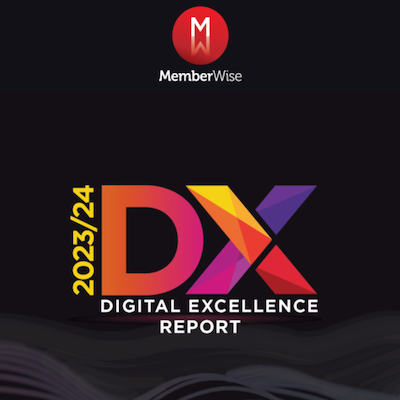The highly anticipated MemberWise Digital Excellence Report 2023/24 was published earlier this week and once again provided an insightful delve into the current landscape of the membership sector.
There were a lot of findings to take away from the report, with 32 pages of statistics, recommendations and industry insights to absorb.
It was great to see the number of system integrations was up from the last report (+5%), however what was telling was the reasons membership bodies gave for not yet fully integrating their business-critical systems:
- Cost
- Incompatibility (between website and AMS)
- Project currently underway
- Time required is too long
- Lack of in-house IT skills
- Poor quality AMS
- Poor quality website
- Don’t know which supplier to use
There are all reasonable reasons why your organisation may not have started (or has stalled) a system integration project. While jargon may seem scary, and costs may seem high, here is what you can do to avoid all these challenges:
Cost
Cost is a concern for many stakeholders when undertaking an IT project. Aside from payroll, IT is one of the highest company expenses. Thorough project planning lets you allocate resources effectively and estimate costs accurately, meaning you have a full idea of costs before you’ve started, and they have been fully optimised.
Plan the long-term integration strategy but break it up into manageable stages and steps to make it easier to manage costs and to ensure the project is running smoothly and on time.
Bear in mind that the reduction in costs from a successful integration project means your organisation will save money in the long run through automation and more accurate data.
Incompatibility (Between Website and AMS)
Firstly, identify the incompatibility issues. Are they related to transferring of data, APIs, functionality, or something else? Once you’ve found where the problems lie, you can start looking for a fix. You should consult with your website and/or AMS vendor who may have a suggested solution or even offer an integration themselves.
From here, you can choose a preferred route to go down that will link up your website with your back-office management systems.
Project Currently Underway
If you are already carrying out a system integration project, and even if you are happy with its progress, it is important to review the current scope of the project to ensure it is not overrunning or going over budget.
Have you planned and highlighted risks associated with the integration? Will there be any incompatibilities later down the line which have not been accounted for or may lead to project creep? While we recommend thorough planning at the beginning of a project, you should constantly review the project on an ongoing basis to ensure everything is well-organised and efficient.
Time Required is too long
An effective integration project can take anything from 6 to 12 months, depending on the size of the organisation and the systems involved. Ineffective planning is one of the key factors for a project overrunning, which is why it’s important to define your objectives and requirements at the beginning of the project.
The time taken to deliver the integration project will be outweighed by the time your organisation will save in the long run. It will free up resource and make it easier for you to access the information and functionality you need. By having multiple systems working as one, it can speed up processes, eliminate data entry errors and improve the general productivity of your teams.
Lack of In-House IT Skills
If you don’t have the adequate resources internally to conduct a full integration project, you can put the project in the hands of a specialist integrator. Whether you want a team to take over the whole project, or whether you need a specialist at director level to oversee the planning and execution of the project, outsourcing the project to a team of experienced integrators will not only provide you with a specialist skillset, but also free up time for your IT teams to focus on their strengths.
Poor Quality AMS
Older systems are known to be slow, cumbersome and hard to integrate with newer technologies.
The quality of your AMS might make it difficult to integrate new technologies, however the use of APIs and integration of third-party ‘bolt-ons’ is a cost-effective way rounds this issue. Bolt-on applications are great because they add functionality to the existing system and make integrations easier.
You can read more about working with legacy systems in this article.
Poor Quality Website
Even if you are not performing an IT system integration project, updating your website if it is poor quality is crucial for acquiring new members and renewing your current members. A recent survey found that 88% online customers are less likely to revisit a site back after experiencing a poor experience.
Perhaps you don’t have the resources or budget to update your website and perform an integration project. However, modernising your website and improving its look and help you go a long way in enhancing your site engagements, ultimately leading to more conversions and higher members.
Once your website has been modernised with an improved user experience, you can then integrate your internal systems into your core site.
Don’t know which supplier to use
Understandably, this is a big factor getting in the way of kick starting a digital project. It’s a major investment and you want to feel assured you’re putting this important project in the hands of people you can trust.
The agency or supplier you go with depends on many factors such as your organisation size, project requirements and your project. However, here are a list of questions to ask your next digital agency:
- What is their track record and experience in membership sector?
- Does the company ask all the right questions about you, your systems and project?
- How high is their attention to detail?
- Are they transparent with their costs?
- What is the company size and culture?
- Are they acting as a partner, not just a supplier?
In summary
There’s some key advice for some of the most common challenges facing your organisation today, and how you can overcome them.
If you need help with your system integration or digital project, talk to us here at PSP. We’d love to help. Don’t forget to download the latest Digital Excellence Report for even more insights like this.
PSP IT Design & Development: For the past 15 years, we’ve been lucky to work with membership bodies, education providers and chartered institutes on their digital strategies. By focusing on People, Systems and Process (PSP), we provide tailored digital solutions that streamline workflows and reduces operational costs. Email [email protected] or phone 01775 722377 to book a free consultation.










Leave A Comment